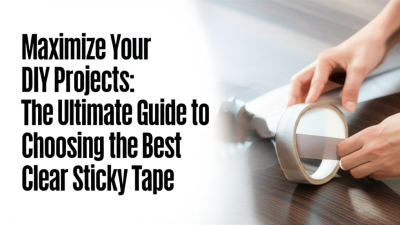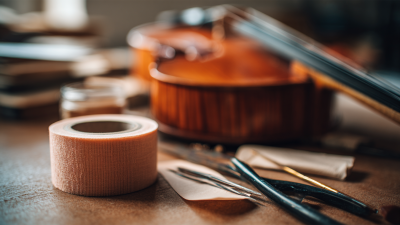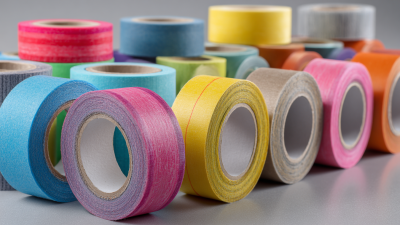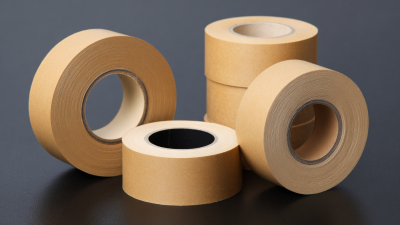Leave Your Message
-
Phone
-
Email
-
Whatsapp


When embarking on DIY projects, choosing the right materials can significantly impact your success, and one item that often gets overlooked is clear sticky tape. This seemingly simple adhesive can be a game-changer, whether you’re crafting, repairing, or organizing.

In "Maximize Your DIY Projects: The Ultimate Guide to Choosing the Best Clear Sticky Tape," we delve into the world of clear sticky tape, exploring its various types, strengths, and best uses. From household repairs to intricate crafts, the right clear sticky tape can streamline your process and enhance your results.
With numerous options available, understanding what distinguishes high-quality tape from subpar alternatives is crucial for any DIY enthusiast. This guide aims to equip you with the knowledge necessary to select the best clear sticky tape for your projects, ensuring that your efforts not only meet but exceed your expectations.
Join us as we unveil essential tips and insights that will empower you in your creative endeavors.
When embarking on DIY projects, selecting the right type of clear sticky tape is crucial for achieving optimal results. There are various types of clear sticky tapes available, each designed for specific applications. For instance, transparent tape is a versatile option used in light-duty tasks such as wrapping gifts or securing lightweight items. According to a recent report by the Adhesive and Sealant Council, the demand for these tapes has surged, with a projected growth rate of 4.1% annually over the next five years.
For more robust applications, packaging tape, often reinforced with fibers, is ideal for sealing boxes and heavier materials. It boasts a higher tensile strength, ensuring that packages remain secure during transit. Additionally, specialty tapes like double-sided tape or masking tape provide enhanced adhesion for specific projects. The Global Tape Market Report indicates that double-sided tape, in particular, has gained popularity in DIY projects, with a market growth expected to reach $10 billion by 2025. By understanding the specific benefits of each type of clear sticky tape, DIY enthusiasts can choose the right product that complements their project needs.
When selecting the best clear sticky tape for your DIY projects,
two key performance metrics stand out: adhesion strength and
durability. According to a report by the
Pressure Sensitive Tape Council, the adhesive properties of tapes can vary widely, impacting their
performance in different applications. High-quality clear tapes typically exhibit a peel adhesion strength of
25 to 60 ounces per inch, making them suitable for various surfaces,
including paper, plastic, and metal. This strength ensures that the tape bonds well initially while remaining
reliable over time.
Durability is equally critical, particularly for projects that require long-lasting results. Research from the
American Society for Testing and Materials (ASTM) suggests that the best clear tapes can withstand
temperatures ranging from -10°F to 200°F, resisting degradation from
environmental factors. Furthermore, studies indicate that UV exposure
can diminish the effectiveness of adhesive bonds, with top-tier tapes offering UV resistance that maintains adhesion for
up to five years outside. By focusing on these performance metrics, users can select clear sticky tape
that not only fits their immediate needs but also stands the test of time in their DIY endeavors.
When evaluating clear sticky tapes, the choice between
biodegradable and conventional options
has significant environmental implications. Biodegradable tapes are made from materials designed to
break down more easily in natural environments, reducing long-term waste. Recent innovations, such as
scientists transforming agricultural waste into clear films, highlight the potential for more sustainable
packaging solutions. As consumers become more conscious of their environmental footprint, they often prefer
products that claim sustainability, further driving the demand for biodegradable options.
Tips for Choosing Clear Sticky Tape:
When it comes to DIY projects, the right clear sticky tape can make all the difference. Understanding the unique requirements of your application is key to selecting the best tape. For projects requiring high transparency, such as photo displays or crafting, opt for crystal-clear tape, which delivers optimal clarity without compromising the appearance of your materials. For lightweight items, a standard clear tape will suffice, but for heavier objects or those exposed to outdoor elements, consider using a stronger variant like packing tape or heavy-duty clear adhesive tape designed to withstand stress and weather conditions.
Different materials also demand specific types of tape to ensure effective adhesion. For porous surfaces like paper, a thin, low-tack tape is ideal, providing a cleaner finish without damaging fragile materials. Conversely, for smooth surfaces such as glass or plastic, a high-tack tape will offer better grip and durability. Additionally, if you’re working with fabric, look for specialized fabric adhesive tapes that are designed to bond textiles without causing fraying or damage. By aligning your tape choice with the particular requirements of your DIY materials, you can enhance the quality and longevity of your projects.
When it comes to maximizing your DIY projects, choosing the right clear sticky tape can significantly impact your results. A recent market research study highlights that the global duct tape market is worth over USD 9.72 billion, which underscores the growing demand for quality adhesive solutions. Understanding the cost-benefit ratio of different options is crucial for making informed purchasing decisions. Look for tapes that offer durability, adhesion strength, and weather resistance at a reasonable price.
Tips: Always check the tape's specifications to ensure it meets your project needs. For heavy-duty tasks, opt for thicker tapes with higher tensile strength. Moreover, consider buying in bulk if you anticipate frequent use, as this can lead to greater savings in the long run. Don’t forget to examine customer reviews to gauge real-world performance and reliability.
Additionally, think about the versatility of the tape you choose. Some clear sticky tapes are designed specifically for certain materials or conditions, which can influence how well they perform. By selecting a tape that aligns with your specific requirements, you can efficiently maximize your DIY efforts while staying budget-conscious.
This chart illustrates the cost and usability benefits of different types of clear sticky tape, allowing consumers to make informed choices for DIY projects.






